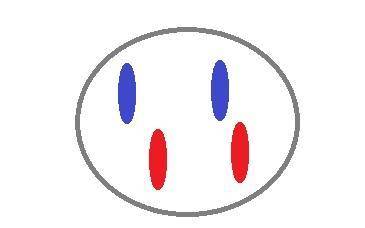
Biology, 12.01.2021 18:30 dragonslayer321
Make a simple sketch of meiosis in a cell with a diploid chromosome number of 4. Now try it when the chromosome number is 3.

Answers: 3
Another question on Biology

Biology, 21.06.2019 17:30
Charles darwin published his theory of evolution in 1859. in what way foes modern evolutionary theory differ from the theory as proposed by darwin? a) darwin inferred that individuals can evolve, but modern generic science has shown that this is not true. b)darwin inferred that individuals do not evolve, but modern genetic science has shown that this is not true. c)modern science has disproved most of darwin's original theory of evolution, because darwin knew nothing about generations and their role in heredity. d)generic studies have shown that gene expression and other factors operate along with natural selection, but most of darwin's theory has been supported by modern science.
Answers: 1

Biology, 22.06.2019 11:00
Many organizations release indexes used to measure the development of the world's countries. as we learned in this lesson, these indexes measure many factors, from life expectancy to happiness. in your opinion, what are the three most important factors we can use to determine how developed a country might be? explain your answers in a few sentences.
Answers: 1


Biology, 22.06.2019 17:30
98 points you will be galileo perform the experiment to determine if objects with different mass fall at the same, or different, rates in the air and in a vacuum. before you conduct your experiment, you need to form a hypothesis. a hypothesis is a prediction of what you think will happen in the experiment. the hypothesis is a statement that describes “if” a certain set of circumstances are present “then” there will be a specific result that will occur. record your hypothesis here: record the results from step one of the experiment (dropping the objects in the air): first trial: second trial: third trial: record the results from step two of the experiment (dropping the objects in a vacuum): first trial: second trial: third trial: did the experiment support your hypothesis? using the data from your experiment, describe why you believe your hypothesis was either proven or disproven. what forces were acting on the objects dropped in the air? what force was acting on the objects dropped in the vacuum? part two: comparing forces choose two forces and compare and contrast these forces. you must provide two ways that they are alike and two ways that they are different. you may make a list, write in paragraph form, or make a chart. choose two forces and compare and contrast these forces. these must be different forces than used in the prior question. provide two ways that they are similar and two ways that they are different. you may make a list, write it out, or make a chart.
Answers: 1
You know the right answer?
Make a simple sketch of meiosis in a cell with a diploid chromosome number of 4. Now try it when the...
Questions









Biology, 10.09.2019 04:30

Mathematics, 10.09.2019 04:30

Mathematics, 10.09.2019 04:30



Computers and Technology, 10.09.2019 04:30






Computers and Technology, 10.09.2019 04:30




